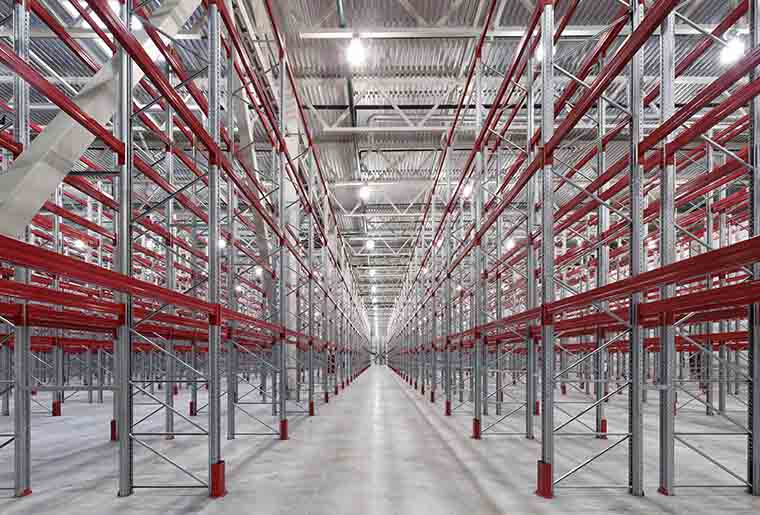Automation in the process of storing goods has revolutionized the logistics sector, especially in recent years. Today, we have cutting-edge technological systems capable of improving warehouse efficiency and optimizing countless processes. Read on to learn more about automated warehousing and get a glimpse into the future of the logistics sector.
What is warehouse automation and why is it transforming logistics?
The process of warehousing automated involves installing logistics solutions that operate automatically to carry out all warehouse operations.
Warehouse automation has a direct impact on logistics in many ways and affects the way we design and manage our warehouses. Today, there is great interest in the positive impact of automation. It is estimated that by 2025, 50,000 warehouses worldwide will already be using some type of automated system. Due to its growing popularity, many are analyzing the challenges and advantages of this new trend in logistics.
The technological pillars of warehouse automation
Warehouse automation is implemented through a series of key technologies. We bring you those that are trending and explain what they consist of:
Advanced robotics: AGVs, AMRs, and more
Advanced robotics are considered robotic systems capable of taking commands and responding to them intelligently. In logistics, these are the most widely used:
- Automated Guided Vehicles (AGVs): These are vehicles that move autonomously, without the need for a human driver, following a predefined route, such as a path within a factory or warehouse. These AGVs are used for transporting materials and loads in industrial environments.
- Autonomous Mobile Robots (AMRs): These are robots that can move autonomously in an environment without the need for constant human intervention. These robots are used in various sectors, such as logistics, industrial automation, and cleaning, to perform tasks such as transporting goods, handling objects, and cleaning facilities.
- Other advanced robots: There are palletizing and depalletizing robots, sorting robots, packaging robots, pick and place robots, conveyors, and robotic arms that, among others, are responsible for automating warehouse tasks.
Automated Storage and Retrieval Systems (AS/RS)
ASRS is an automated merchandise storage and retrieval system whose objective is to optimize warehouse tasks to improve company performance. Through ASRS, unit loads are stored and retrieved using different types of machines, which can move vertically or horizontally, depending on the system implemented and the type of merchandise.
Warehouse Management Software (WMS) and its Integration
A Warehouse Management System (WMS) is software that helps companies control and optimize warehouse operations, from receiving to shipping goods. The integration of a WMS, especially with other systems such as ERP or TMS, can significantly improve efficiency and reduce errors in the supply chain.
Artificial intelligence and machine learning in optimization
Artificial intelligence (AI) is increasingly widespread in logistics 4.0. For example, AI can help make more accurate forecasts when preparing demand forecasts, which prevents stockouts and can reduce costs. It is also an ally when preparing other supply chain operations.
Specifically, machine learning is the type of artificial intelligence that processes huge data sets to detect patterns and trends, and then uses them to build models that predict what might happen in the future, becoming smarter over time in a continuous process.
IoT sensors and real-time data collection
IoT sensors enable real-time data collection in warehousing, providing crucial information to optimize inventory management, improve efficiency, and reduce costs. These sensors measure parameters such as temperature, humidity, location, and stock levels, facilitating data-driven decision-making.
Tangible benefits of warehousing automation for the supply chain
The adoption of warehousing automated generates a cascade of tangible benefits that positively impact the entire supply chain.
Increased operational efficiency
First, there is an exponential increase in operational efficiency. Automated systems, such as mobile robots and AS/RS, perform repetitive and complex tasks with a speed and consistency unattainable by manual labor. This translates into faster processing cycles, increased throughput, and overall optimization of warehouse workflow.
Cost reduction
Second, automation leads to significant long-term cost reduction. While the initial investment may be considerable, the reduced dependence on manual labor, the reduction in costly errors, the lower energy consumption of some automated systems, and the optimization of inventory generate substantial savings over time, offering an attractive return on investment.
Increased accuracy and error reduction
Dramatically improved accuracy and error reduction are another key benefit. Automated systems, guided by advanced software and precise sensors, minimize human error in tasks such as order picking, packing, and shipping. This precision translates into greater customer satisfaction, fewer returns, and more reliable inventory management.
Space Optimization
Space optimization and increased storage density are essential, especially in urban environments with high real estate costs. AS/RS systems enable efficient vertical storage, maximizing warehouse height and reducing the footprint required to house the same volume of goods. This frees up valuable space for other operations or allows for expanded capacity without the need for a facility expansion.
More Agile and Faster Order Picking
Furthermore, automation drives a significant increase in the speed and agility of order picking. Robots and automated transport systems can quickly locate and retrieve items, preparing orders more efficiently and reducing delivery times. This agility is crucial to meeting customer demands in an increasingly demanding market.
Improved Workplace Safety and Risk Reduction
Finally, warehousing automated contributes to improved workplace safety and risk reduction. By delegating dangerous or ergonomically challenging tasks to robots, the risk of workplace accidents and injuries among employees is reduced, creating a safer and healthier work environment.
Key Challenges and Considerations in Implementing Automation
Despite the numerous benefits, implementing automation in warehousing presents key challenges and considerations that companies must carefully address.
Initial Investment and Return on Investment (ROI)
The acquisition and implementation of automation technologies require a significant investment, and companies must conduct a thorough ROI analysis to understand the timeframe within which the investment will be recouped and benefits will begin to be generated.
Integration with Existing Systems and Interoperability
New automated systems must communicate and work seamlessly with warehouse management software (WMS), enterprise resource planning (ERP) systems, and other technologies already in place. A lack of interoperability can create bottlenecks and reduce overall efficiency.
Workforce Adaptation and the Need for New Skills
Automation will transform existing job roles, and companies must invest in the training and development of their employees so they can operate and maintain the new automated systems. Change management and clear communication with the workforce are crucial for a successful transition.
Cybersecurity and Data Protection
Cybersecurity and data protection become increasingly relevant as warehouses become more connected. Automated systems generate large amounts of data, and companies must implement robust measures to protect this data from unauthorized access and cyberattacks.
Scalability and Flexibility for Future Needs
Finally, scalability and flexibility for future needs are strategic considerations. Companies must select automation solutions that can adapt to future growth and changes in market demand. The flexibility to integrate new technologies and expand system capacity is critical to maintaining long-term competitiveness.
Success stories and examples of warehousing automated in action
“There are plenty of examples of companies that have improved the quality of their services thanks to warehousing automated. It’s time to take note and learn from the great visionaries in the world of logistics:”:
Amazon
This giant leads the way in task automation through technology and algorithms that it uses to optimize logistics and storage in its distribution centers.
Ikea Components
An excellent example of resource utilization. It implemented an automated warehouse from an existing manual warehouse.
Countless manufacturing companies have optimized their internal logistics through warehouse optimization. Furthermore, SMEs around the world have already implemented smart solutions for storing their products.
In this landscape where automation redefines logistics and supply chain efficiency, Partida Logistics stands as your strategic ally to successfully navigate this transformation. With a forward-thinking vision and deep industry experience, we offer comprehensive and customized warehouse automation solutions, from initial consulting to the implementation and maintenance of state-of-the-art systems.
We understand that every warehouse is unique, which is why we work closely with you to identify the most appropriate technologies for your specific needs, whether AGVs and AMRs for smart mobility, AS/RS systems for vertical space optimization, or the integration of WMS software and artificial intelligence for predictive and efficient management.




